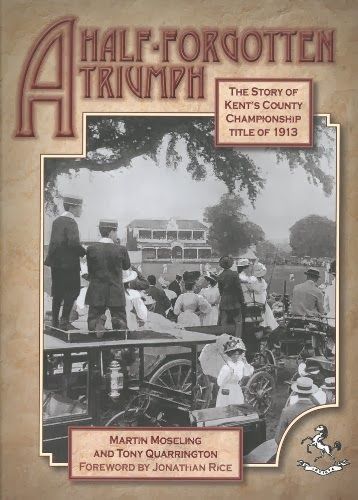
Book Review - A Half-Forgotten Triumph: The story of Kent's 1913 County Championship title

OK, from the start I will declare a specific interest in this book, as anything covering the so-called ‘Golden Age’ prior to the First World War will always arouse my interest.
It was an age of gentility, innocence and huge interest in cricket, with the first-class calendar featuring some of the giants of the game’s history. WG had gone, but youngsters like Jack Hobbs and Frank Woolley had emerged to capture the imagination of the large cricketing public. They read about these players; but to see them, they had to go to games. And they did, in large numbers.
Woolley was, of course, a batting genius, subject to periods of fallibility but more often than not a player of extraordinary charm, who could make batting look like the easiest thing in the world. By the time his career ended in 1938, he had amassed a staggering 59,000 first-class runs, not to mention 2,000 wickets with slow left-arm and over a thousand catches. It is safe to say that we will never see his like again.
He was a poor starter, but then set his sights on dominating the bowling and did so in a spectacular fashion. His carefree attitude accounted for a first-class average that just cleared forty, yet he ensured the love and admiration of generations of cricket followers. He was a mainstay of the side at the age of 26 in 1913, but by no means a one-man band.
Opening batsman Wally Hardinge was close to 2,000 runs, one of eighteen occasions on which he passed a thousand runs in stylish manner. James Seymour was an excellent number three and outstanding fielder, while Edward Humphreys was another who, like Seymour, passed 1500 runs in an excellent summer for the ‘Garden of England’ county.
Like all good sides they had people down the order who contributed runs when most needed and in Fred Huish had a wicket-keeper worthy of a place in an outstanding lineage through Ames, Evans, Knott and Downton.
Seam bowler Arthur Fielder often made early breakthroughs, but Kent had the greatest slow left-arm bowler of the period in Colin Blythe. While his powers were on the wane – and the book points out that he was set to retire from cricket to become a coach after the war in which he was killed – he was still good enough to take 145 wickets at just 15 in the season.
2,500 wickets at 16 in a career: the statistics are extraordinary but reflect a bowler in complete control of his powers. Like Yorkshire’s Wilfred Rhodes, his greatest weapon was flight, turning it just enough to beat the middle. He enjoyed success against batsmen who ‘took him on’ in the spirit of the day; but from a classic action, he bowled long spells without any diminution of his powers.
The fixture lists of the time meant that counties didn’t necessarily play all of the others, and Kent’s success came despite no fixture against a fairly mediocre Derbyshire side of the time. Common sense dictates that this side may have disposed us very easily.
This is a terrific read and deserves a far wider audience than Kent fans alone. Martin Moseling is an occasional contributor to the blog, and the authors deserve full credit for a book that is an absolute delight from start to finish. Lavishly illustrated, with pictures of players and grounds from the period throughout, I savoured every turn of the page.
It is a book I have had for some time but took my time over. Now it is finished, I may just start it all over again. Shortlisted among the cricket books of the year, it certainly makes it into Peakfan’s top three.
A Half-Forgotten Triumph: the Story of Kent’s County Championship Title of 1913 by Martin Moseling and Tony Quarrington is published by Sports Books and is available through all good book shops. It is also available on Amazon, currently at £19.81